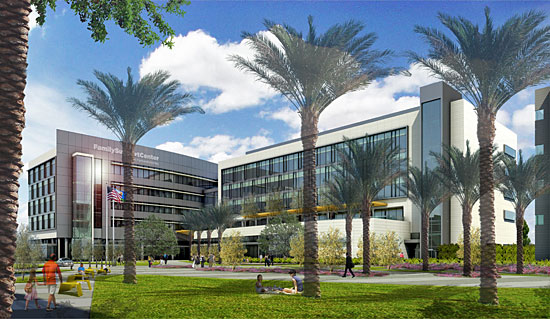Bringing the family together
September 12, 2013

A rendering of the San Fernando Valley Family Support center, which will provide a new, collaborative model for bringing government to the people.
Problems don’t always come one at a time.
When families need help for more than one reason, they often have to visit various locations and wait in lines while navigating the bureaucracies of multiple government agencies. But an innovative project in the San Fernando Valley will streamline that process by cutting the red tape in a new, state-of-the-art facility.
The San Fernando Valley Family Support Center, which breaks ground in Van Nuys on Saturday, Sept. 21, will bring seven Los Angeles County departments under one roof—in a building specially-designed to foster collaboration. Michael Samsing, who has worked on the project for the county Chief Executive Office since 1999, said the center will bring government to the people in a new way.
“It’s a one-stop location where families can access all the services that can help them,” Samsing said. Whether it’s food assistance, parenting skills or a child on probation, he said, “we’re going to get all the departments working together for the one client that comes to get services.”
This is the first time this kind of team effort has been planned from the ground up, Samsing said. Previously, departments have been co-located in a single building but didn’t fully integrate their operations, remaining separated by walls and layers of bureaucracy.
Samsing saw some of those barriers fall at meetings during which departments provided input on the project. “It was interesting to hear departments realize that they have common clients, that there are other services we can provide,” he said. “We all work in silos and this is really meant to blow that up.”
It all starts with the building—a five-story structure designed by HKS Architects, Inc. Thom Greving, the project designer, said the job reached the heart of what it means to be an architect. “People think we design buildings, but that’s secondary to what architecture really is—to craft experiences,” he said.
The design employs fewer walls and plenty of common areas, along with shared meeting rooms and group workstations in an open, campus-like environment. To create an uplifting work environment, Greving included a healthy dose of sunlight; 90% of employees will be within 30 feet of a window. The campus features walking paths, bike racks and plenty of greenery, including 380 new trees and a large, live oak as the centerpiece for the courtyard. Clients will enter a shared lobby, where they’ll check in through kiosks or greeters, Greving said.
The complex will be built on county-owned property on Van Nuys Boulevard, in an area that was found to have the highest concentration of social service cases in the valley, according to a study commissioned by the CEO in 2000. Two empty county facilities and a vacant bowling alley have been razed to make way for the new project. (The Mid-Valley Comprehensive Health Center, also located on the property, will continue to operate throughout construction and afterwards.)
The new building is targeted to achieve LEED Gold certification for environmental sustainability, but Greving said it might even make LEED Platinum, a much rarer distinction. Efficient heating and cooling systems will be installed in floors and bio-filtration gardens will serve as retention ponds to clean storm water runoff.
Each of the departments that will be housed there—Children and Family Services, Public Social Services, Child Support Services, Probation, Health Services, Mental Health and Public Health—will pay part of the $175.9 million price tag. Supervisor Zev Yaroslavsky, who has been involved in planning since the beginning, has also allocated $9.6 million to the project.
The support center also could provide much-needed economic revitalization in the area, said David Howard, who is managing its construction for the Department of Public Works. “With all the county employees and visitors,” he said, “there will be a lot of people seeking restaurants and shops.”
With construction underway, Samsing and another county CEO employee, Carlos Pineda, will focus on the operational details. Pineda is optimistic about the new environment, but he acknowledged that challenges remain. Technological incompatibilities, legal issues and requirements on how funds can be spent are all hurdles to confront. Pineda and Samsing hope their work will become a blueprint for future service, a more efficient model that will help families become aware of the full spectrum of assistance that county government can provide.
“Up until now we have been focused on the space,” Pineda said. “Now we’re figuring out how it will all work together.”
Posted 9/12/13












 405 bridge work causes a stink
405 bridge work causes a stink
